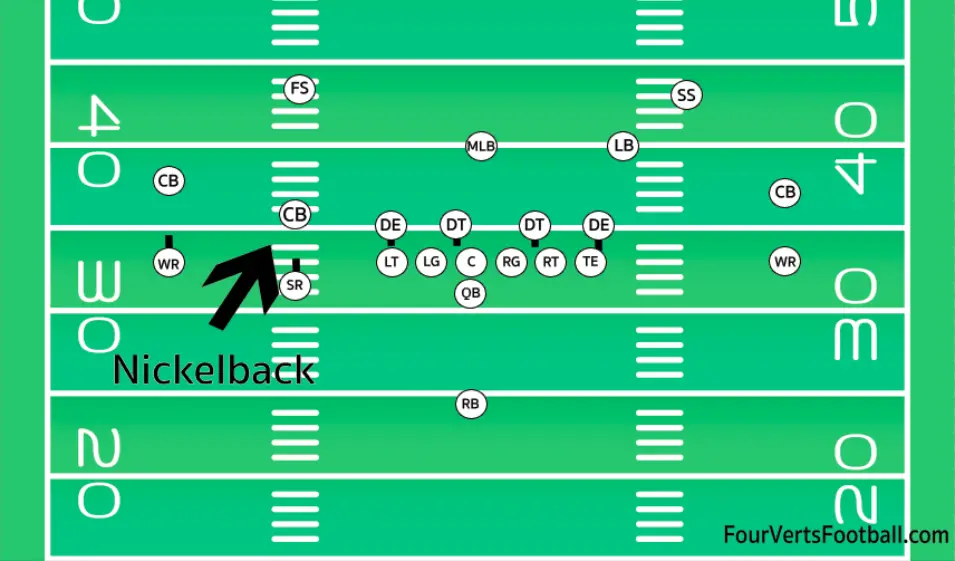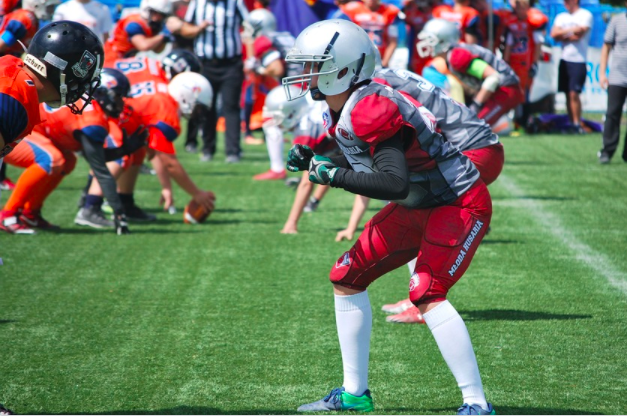A nickel defense in football refers to a defensive alignment that utilizes five defensive backs. The majority of formations in football use four defensive backs instead of five. In most cases, this extra defensive back is a cornerback but safeties can be used as well.
When running a nickel defense it is most often a linebacker that is taken off the field in order to add the extra defensive back. This is done because taking a defensive lineman instead would leave you more susceptible to the run game.
Advantages
No mismatches
One benefit of the nickel defense is that you are much less likely to have to receiver mismatches.
In today’s game running backs, tight ends, and fourth receivers can present a great receiving threat.
In many situations, your defense will be forced to play coverage that puts a linebacker on one of these receivers.
These are the exact sort of mismatches the opposing offense is looking for. This will often make it difficult for the defense to stop the opposing teams passing attack.
By using a nickel package you’ll find mismatches are much less common.
The five defensive backs on the field will be able to match up receivers and will rarely leave your linebackers with a tough assignment.
Overall Improved Pass Defense
The largest benefit of a nickel defense is its effect on the pass coverage.
Everyone knows that passing in the NFL is becoming more prevalent in recent years. As the game gains a passing focus this sort of package becomes much more effective.
Teams that offensive system relies on passing will struggle against this sort of defense.
Although it creates an easier front to run against this defense is effective against the pass.
Disadvantages
Run Defense
Run defense is one aspect that is going to take a step back when using a nickel defense.
The reasoning for this is quite simple the majority of defensive backs aren’t going to have the same run-stopping ability as a linebacker.
Since a linebacker is coming off the field for the fifth defensive back your defense is going be smaller and lighter.
This is going to make it more difficult to fight off blocks as well as bring down the running back. It is unlikely that your third cornerback or safety is going to perform these aspects as well as one of your starting linebackers.
That being said it is only the rotation of one linebacker for a defensive back so it will not necessarily have a large effect on the game.
Blitzing Ability
The other aspect that may take a step back when using the nickel defense is your blitzing ability. In most cases that extra defensive back is not going to feature that same skill level that a linebacker has.
Due to the larger size of linebackers, they are typically better blitzers than defensive backs.
This will affect the teams ability to get to the quarterback on these passing plays. If the four-man pass rush is not effective then the ability to blitz is quite important.
Nickel Vs Dime Defense
The difference between a nickel defense and a dime defense is that a dime defense features six defensive backs instead of five.
In the nickel defense a linebacker is replaced with a defensive back. This means there are five defensive backs on the field. This usually is fielded with three corners and two safeties.
When running a dime defense you are going to take off two linebackers to add two more defensive backs. This means there is a total of six defensive backs on the field. In most cases, this consists of four cornerbacks and two safeties.
The dime defense is used almost exclusively in passing situations. This is because the lack of linebackers in this formation make it very difficult to stop the run.
Why is it called a nickel defense?
Now that you know what a nickel defense is in football you may be wondering how it earned its name.
The reason this defense is called a nickel defense is that it includes a fifth defensive back.
Since there are five defensive backs the term nickel which is worth five cents fit the bill.
Furthermore, this use of coins to name defenses is used for more than just the nickel defense.
As we explained above the dime defense is a formation that includes six defensive backs. When a defense uses a formation that includes seven defensive backs this is called a quarters defense.
Each time another defensive back is added to the defense it is named after a coin of increased value.
A nickel for five dbs a dime for six dbs and a quarter for seven dbs. Out of these defenses the nickel is far and away the most common.
The quarter defense for example is only used in situations in which the opposing team needs to pass the ball downfield in a hurry.
What is a nickelback in football?
A nickelback in football is the name of the position that the fifth defensive back plays in a nickel defense.
These players are also referred to as a nickel corner. Due to the increased passing in today’s NFL nickel corner has become a valuable position.
Instead of sending in a third-string cornerback to be the fifth defensive back each team will now carry a player specifically for this position.

These players specialize in playing pass coverage from the slot. These players will almost always line up in the slot between an outside receiver and the rest of the formation.
Due to their close proximity to the middle of the field nickel corners need to be proficient at run-stopping.
As we covered earlier in this article the players are not going to be as capable in run defense as a traditional linebacker. Though they will need to be better than your average cornerback when it comes to tackling the ball carrier.

